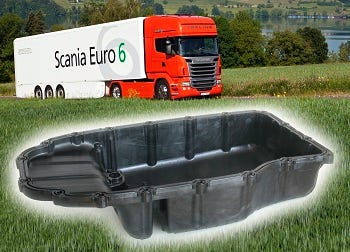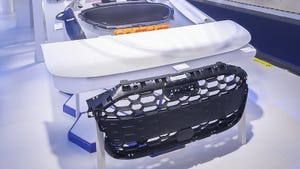Polyamide oil sump weighs half as much as aluminum alternative
An oil sump molded from DuPont Zytel polyamide resin is helping the Swedish commercial vehicle manufacturer Scania meet new challenges with regard to noise, emissions and weight. The lightweight yet equally robust oil sump—the lower shell of the oil pan module—is among the host of innovative technical solutions incorporated by Scania in its new Euro 6 engines.
July 4, 2012
An oil sump molded from DuPont Zytel polyamide resin is helping the Swedish commercial vehicle manufacturer Scania meet new challenges with regard to noise, emissions and weight. The lightweight yet equally robust oil sump—the lower shell of the oil pan module—is among the host of innovative technical solutions incorporated by Scania in its new Euro 6 engines.
The large component was molded in Sweden by the Plastal Group AB (Gothenburg), a leading supplier of engineered plastic components to the automotive industry, with the material, design and processing support of DuPont representatives in the country and across Europe and the input of prototype specialists Idé-Pro (Skive, Denmark).
|
Nylon sump pan is lightweight, dampens noise to boot. |
Among the range of technological highlights incorporated within the new 440- and 480-hp (324- and 353-kW) 13-litre Euro 6-compliant engines, unveiled by Scania in spring 2011, is the premiere of an oil sump molded from a heat-stabilized, glass-fiber-reinforced grade of Zytel 66 nylon. The adoption of the DuPont material for this application—a first for the truck market and only the second development for commercial production vehicles worldwide following the launch of a Daimler oil pan module in 2008—has enabled a reduction in the weight of the component by over 50%, or 6 kg, versus its aluminum predecessor to improve fuel economy and reduce emissions. Scania also found that switching from metal to plastic in the oil sump dampens engine noise to help meet Euro 6 noise emission standards.
The particular grade of Zytel used for the Scania oil sump is a 35% glass fiber reinforced, heat stabilized and lubricated polyamide 66 said to be a material of choice for harsh, underhood applications involving high temperatures and oil. Thanks to its low melt viscosity it reportedly readily fills thin section molds, which, in combination with fast setup times, contributes to very fast molding cycles. According to the development team at Scania, the main reasons for choosing Zytel nylon were that it meets technical requirements when used in oxidized oil and still provides the necessary level of impact performance.
Having settled on the initial design and material, Scania contacted Idé-Pro to undertake the first steps in the part's development. Idé-Pro not only produces tools and molds components, but also offers the development tools and expertise needed during the prototype stage. In such a way the design of the mold could be optimized to minimize warpage.
Beyond material selection, DuPont also assisted Scania in refining the sump's design and the production process, particularly with regard to achieving a consistently tight seal between the sump and the engine. This required very precise tolerance control of a large component, measuring 847 mm (length) x 467 mm (width) x 203 mm (height), achieved by comprehensive mold flow analyses, prototype testing, and ongoing optimization of processing parameters.
"Ribbing on the underside of the sump also plays a key role in remaining within the permitted tolerances for the part, as well as performing a secondary function as a defensive shield against stone impacts," says Murray Smith, development specialist at DuPont Performance Polymers in Sweden.
Its effectiveness in this role was tested at the DuPont European Technical Centre in Geneva, where a high-speed impact, compressed-air cannon was used to fire steel balls at an angle of 45 degrees and at a speed of 80 kph (50 mph) at the sump. These tests confirmed that the ribs effectively dissipate the impact energy, becoming damaged in the process, while the structural integrity of the sump remains preserved. —[email protected]
About the Author(s)
You May Also Like



